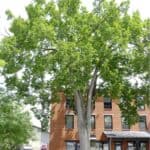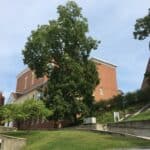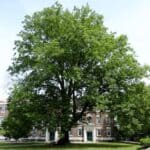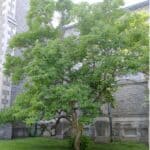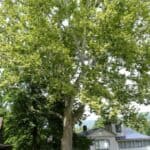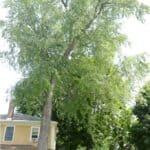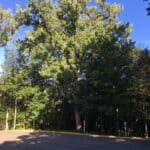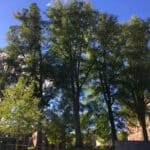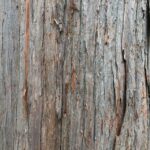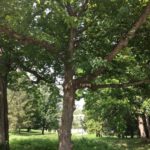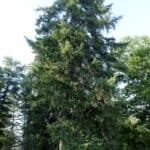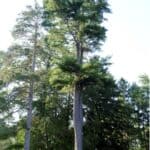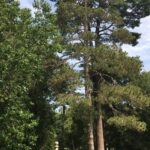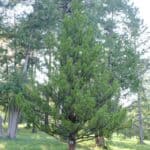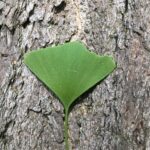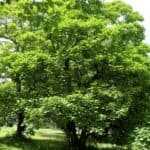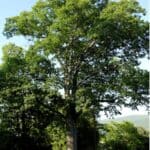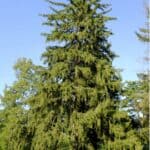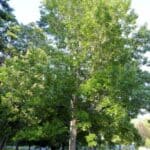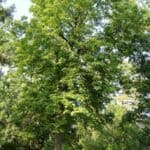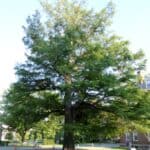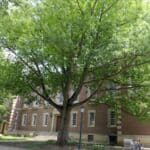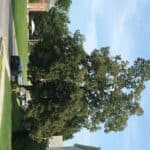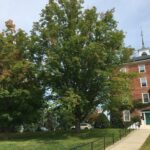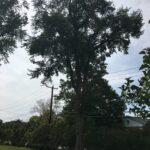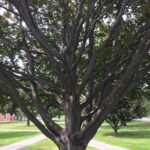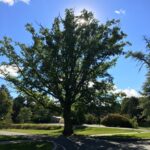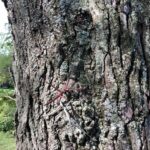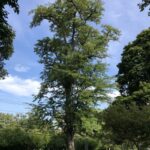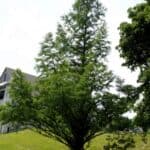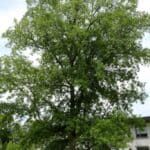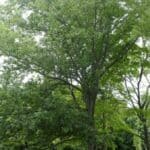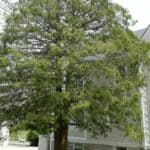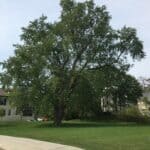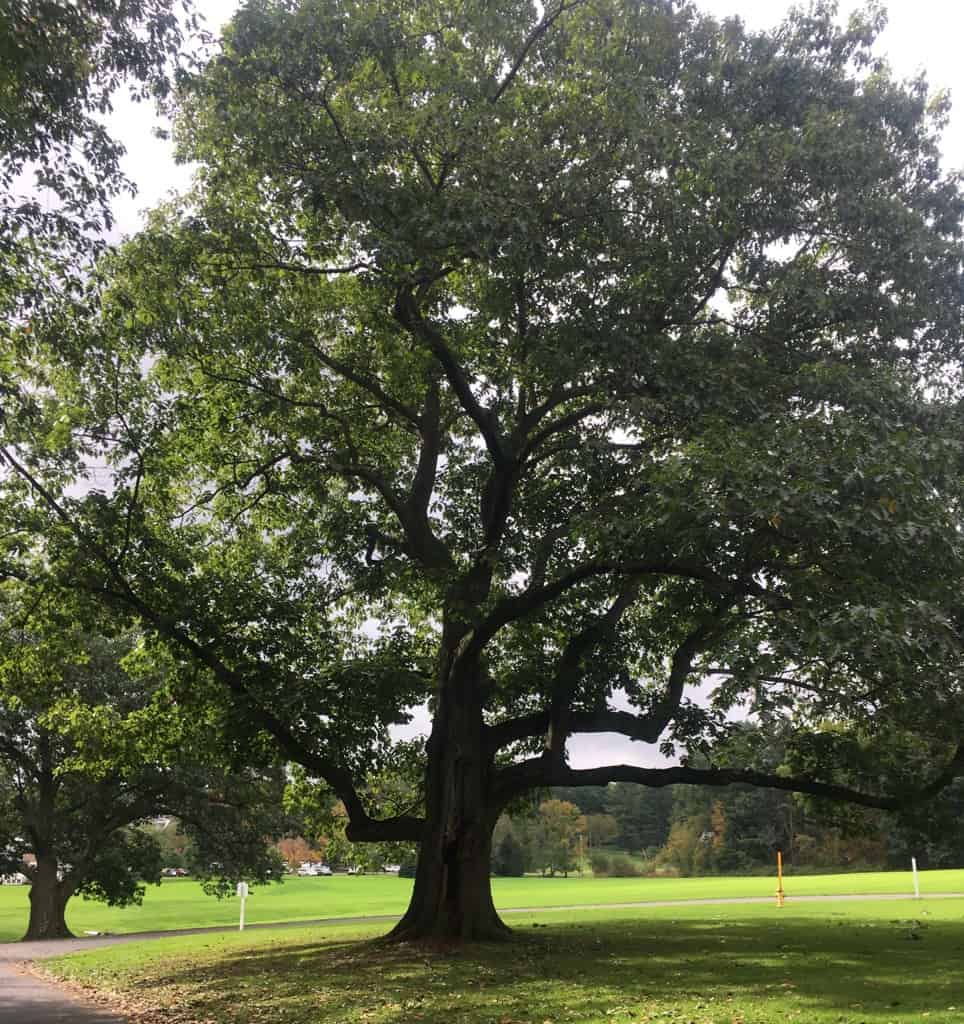 Enjoy a walk around town with this self-guided tour of some of Williamstown’s notable trees.
Enjoy a walk around town with this self-guided tour of some of Williamstown’s notable trees.
Choose a convenient section or walk the whole, and then range further out with other tree tour recommendations on this website.
A tour for all seasons: blooms of the magnolia, tulip tree, horse chestnut, black locust and catalpa delight in the spring. Discover the varied leaf shapes, colors and textures with the ginkgo, copper beech and oak. The sugar maple foliage is radiant in the autumn; seed pods of the honey locust and sweetgum intrigue. Winter snows dusting hemlock, pine and spruce branches outline the trees’ forms. In all seasons, examine the bark of the hinoki false cypress or hop-hornbeam.
The historical photograph at #28 shows a view of Main Street lined with majestic American elms. Many trees have been lost over the last century, one mighty elm, in fact, died off while this guide was in production.
A walk for discovery and delight.
Description of Trees
(DBH = diameter at breast height; H = height)
American elm (Ulmus americana). DBH 38”. H 68’. Majestic and graceful, with a distinctive “vase-like” crown. In the early 20th century there were thousands of american elms in Williamstown. The species was devastated by dutch elm disease and by the mid-20th century most had died and been removed. About ten american elms remain along Williamstown streets today, including this one, at the northwest corner of the B & L (Tunnel City) building. See also #4 and #28.
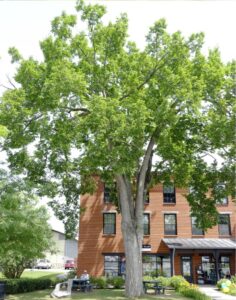
Walk up Spring St. and turn right at Pappa Charlie’s and walk through Chandler Plaza.
Black walnut (Juglans nigra). DBH 30”. H 98’. On the steep hillside between the back of the college art museum and the steps leading up to Prospect House. Gray-black bark. Large spherical nuts, enclosed in a husk that stains your hands, drop in the fall.
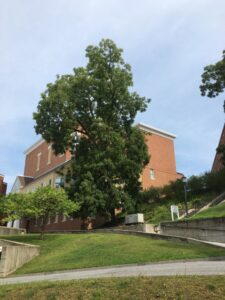
Go up the steps and turn right into the Berkshire Quad.
Northern red oak (Quercus rubra). DBH 55”. H 113’. At the southeast corner of the Berkshire Quad. Red oaks are increasingly common in Williamstown, both in town and in the woods. Distinctive ridged bark with reddish stripes. See also #11, #19, and #25.
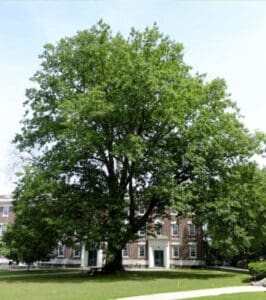
Saucer magnolia (Magnolia x soulangeana). DBH 15”. H 48’. Located in a sheltered spot between Thompson Memorial Chapel and Griffin Hall. A hybrid. Bears large pinkish flowers in the spring. Flowers are thought to be shaped like a cup-and-saucer – hence the name.
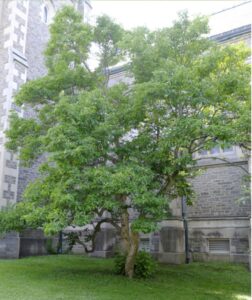
American sycamore (Platanus occidentalis). DBH 65”. H 112’. In front of Mason House. Sycamores often grow very tall. Bark on a young sycamore peels off as the tree grows, leaving (as on this example) a mottled gray-and-white smooth surface above and a darker rougher gray below.
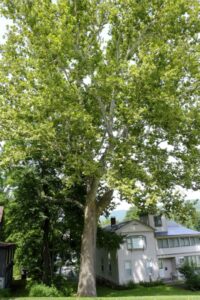
Cross Southworth St., and pause on the north side of Main St. and look east to see a row of mature Sugar Maples on either side of the sidewalk, giving you some sense of what the town looked like a hundred years ago when five rows of Elms extended from Cole Avenue to Field Park.
Silver maple (Acer saccharinum). DBH 44”. H 100’. Between the house on the NE corner and Southworth St. Shaggy bark. Fast-growing. A common street tree, native to stream banks in this region. As opposed to a sugar maple (Acer saccharum), its leaves tend to turn yellow in the fall, and to drop early. See also #36.
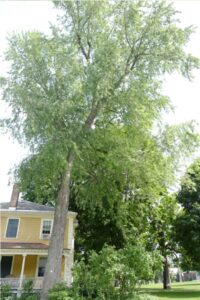
Cross back to other side of Southworth St. Walk uphill on a path through the small woods behind Mason House into the parking lot behind the chapel.
Eastern cottonwood (Populus deltoides). DBH 41”. H 102’. On your right. Eastern cottonwoods are one of the largest trees in the Eastern U. S., often growing very tall. Native to wetlands, such as Lower Linear Park. Bark becomes deeply fissured as the tree ages. Leaves are deltoid (triangular) shaped, hence the name.
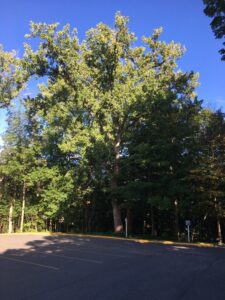
English elm (Ulmus procera). DBH 38”. H 103’. A double row of english elms, more resistant to Dutch elm disease than the American elm, was planted along the walk leading to the south entrance of Stetson-Sawyer Library when it was completed in 1922. The english elm typically grows tall and straight, but without the “vase-like” crown of the American elm.
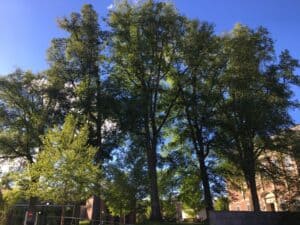
Walk left around the library, continue north, bearing left at Mission Park Dr. and right on Stetson Rd.
Hinoki false cypress (Chamaecyparis obtusa). DBH 20”. H 90’. Native to Japan. Dark red-brown bark. Slow-growing. Produces high-quality timber.
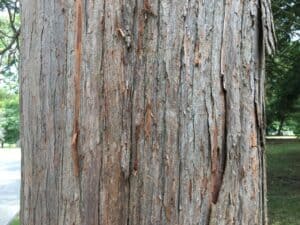
Continue on Stetson Rd. past the tennis courts to the turnoff to the Field House.
Northern red oak (Quercus rubra). DBH 49”. H 72’. A double row of red oaks was planted along Stetson Rd. in 1912. When planted in the open, red oaks are often as broad as they are tall, with large lower limbs growing out at 90 degrees to the trunk. See also #3, #19, and #25.
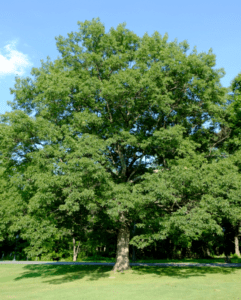
Retrace steps to Mission Park.
Hop-hornbeam (Ostrya virginiana). DBH 22”. H 47’. Shaggy bark, very hard wood. Commonly a small tree, this one is unusually tall. Fruit hang in pendulous clusters, resembling the fruit of hops.
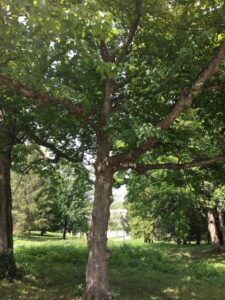
Eastern hemlock (Tsuga canadensis). DBH 29”. H 80’. Distinctive very small cones. Slow-growing and long-lived. Common along Cold Spring Rd. and Torrey Woods Rd. and in Flora’s Glen. The bark once used to tan leather. Hemlocks are currently threatened by the woolly adelgid insect.
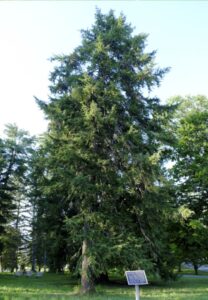
Eastern white pine (Pinus strobus). DBH 38”. H 115’. Next to a red pine. One of the tallest species in Eastern North America, with a straight trunk. Needles grow five in a cluster. Widespread in Williamstown at the time of European settlement, but almost all the old-growth trees were harvested for lumber as early as the late 18th century.
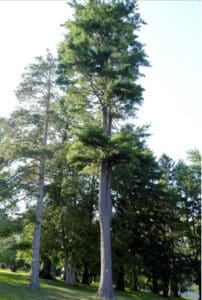
Red pine (Pinus resinosa). DBH 25”. H 85’. Next to a white pine. Straight trunk, often with a few low-lying limbs, though usually not as tall as a white pine. Needles grow in groups of two. Bark at the top is orange-red, though gray-brown at the base.
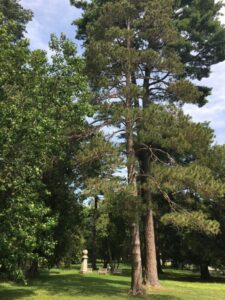
From here turn back downhill and walk past the Haystack Monument.
Japanese umbrella pine (Sciadopitys verticillata). DBH 13”. H 31’. Native to Japan, where it is considered sacred, and introduced to Europe and North America in the 1860s. Not a true pine. Long needles, whose whorls resemble the ribs of an umbrella.
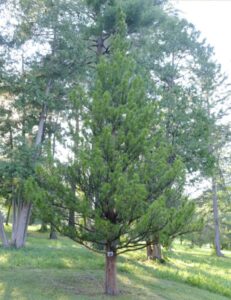
Gingko (Gingko biloba). DBH 19”. H 60’. Also called maidenhair tree, from similarity of its leaves to those of the maidenhair fern. Native to China, but long naturalized around the world as an ornamental. Long-lived. Fan-shaped leaves turn a beautiful yellow in the fall.
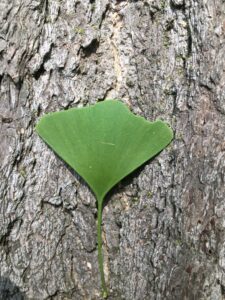
Northern catalpa (Catalpa speciosa). DBH 37”. H 50’. Typically twisted and contorted branches. Big, showy (speciosa means showy) clusters of white flowers in the spring. Leaves come out very late and drop suddenly after the first hard freeze in the fall. Cigar-shaped fruits split open in late fall, releasing winged seeds.
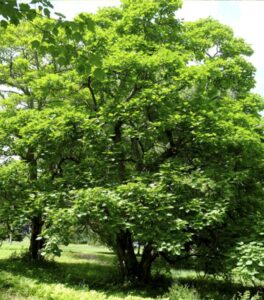
Northern red oak (Quercus rubra). DBH 67”. H 122’. On the west edge of Mission Park, opposite the driveway to 123 Park St. The tallest tree in the Park and the stoutest. See also #3, #11, and #25.
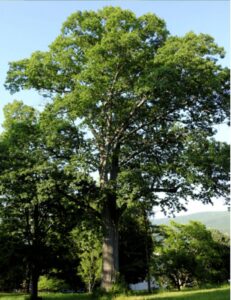
Norway spruce (Picea abies). DBH 30”. H 105’. Several examples in Mission Park. Fast-growing. Distinctive downward-hanging branchlets and long seed-cones. Widely planted in Williamstown as an ornamental, and on abandoned farms in the 1930s by the Civilian Conservation Corps.
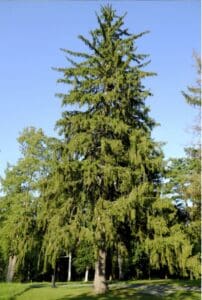
Tulip tree (Liriodendron tulipifera). DBH 37”. H 114’. Sometimes inaccurately called a yellow poplar, but related to a magnolia and not to a poplar. Named for the tulip-shape of its leaves and flowers. Fast-growing, but typically short-lived, its wood soft and easily carved. The tallest of eastern hardwood trees. Typically a perfectly straight trunk.
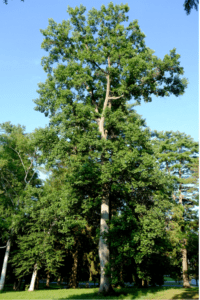
Sweetgum (Liquidambar styraciflua). DBH 16”. H 50’. Name derives from the fragrant resin which flows from the bark when cut. Distinctive five-pointed glossy leaves, and abundant globular spiny seed pods.
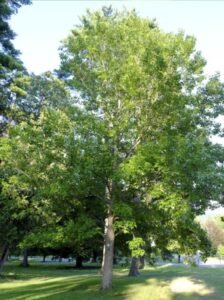
Horse chestnut (Aesculus hippocastanum). DBH 26”. H 82’. Distinctive glossy brown nuts enclosed in spiky spherical fruit: toxic for humans, but squirrels find them tasty. Spectacular clusters of ivory- colored flowers in the spring.
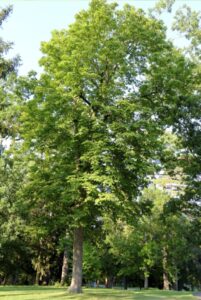
Bald cypress (Taxodium distichum). DBH 51”. H 79’. Just north of Williams Hall. Normally does not grow this far north. A conifer that drops its leaves in the fall – hence “bald.” Slow-growing, long-lived.
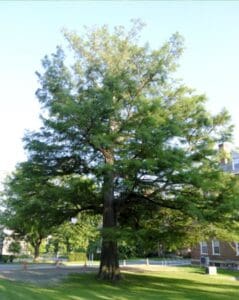
Northern red oak (Quercus rubra). DBH 41”. H 85’. SE corner of Freshman Quad. A number of red oaks were planted here in the mid-1920s, when Williams Hall was built. Taller than the red oaks on Stetson Rd., which were planted in the open: these oaks are reaching for sunlight. See also #3, #11, and #19.
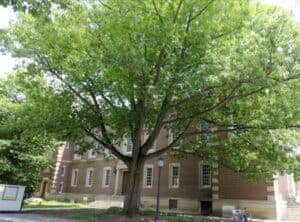
Little-leaf linden (Tilia cordata). DBH 24”. H 56’. Beside the First Congregational Church, at the corner of Main St. and Chapin Drive. Native to Europe. Also called a basswood or lime (though it is not related to the citrus tree that bears limes). Common street tree in Europe, best known at Unter den Linden, a tree-lined boulevard in Berlin.
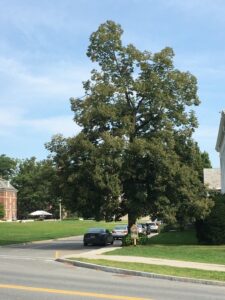
Cross Main St. at the crosswalk and bear right of Morgan Hall into the Science Quad.
Sugar maple (Acer saccharum). An example at the southeast corner of the Science Quad (DBH 20”. H 47’) and another at the northwest corner (DBH 27”. H 62’). Glorious orange and red-orange leaves in the fall, and much prized by tourists as well as residents. Source of maple sugar – “sugaring” is conducted every spring in Hopkins Memorial Forest and elsewhere in town. But sugar maples are in decline because of acid rain, climate change, road salt, and diseases.
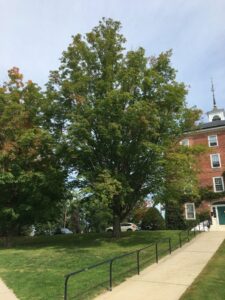
Walk out to Main St. but stay on the south side of the street, and look across to #28.
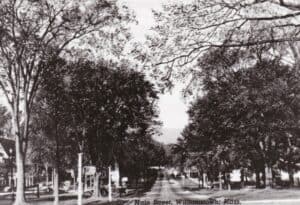
American elm (Ulmus americana). DBH 35”. H 48’. In the side lawn to the west of the President’s House on Main St., close to Park St. See also #1 and #4.
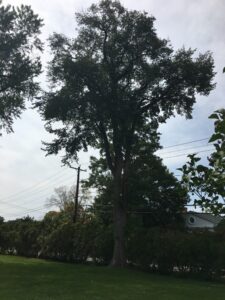
Copper beech (Fagus sylvatica). DBH 23”. H 48’. Also known as European beech. Between Main Street and the sidewalk, in front of Spencer House. Smooth gray bark. Leaves turn coppery-purple in the fall. Often holds leaves through the winter. Squirrels like beechnuts. Other good examples at 67 Cold Spring Rd. and 170 The Knolls.
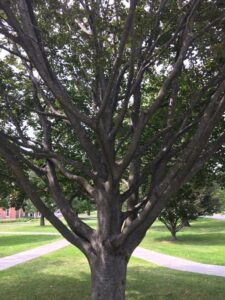
White oak (Quercus alba). DBH 40”. H 63’. A street tree between Milne Library and Center for Developmental Economics (CDE), opposite Field Park. Slow-growing, long-lived, and often huge. Light gray bark. Name comes from the color of the wood, used because rot-resistant for door sills and window frames. Once very common in Williamstown, in the neighborhood still known as White Oaks, but now rare in town – the biggest surviving example is on Bridges Rd., near its intersection with White Oaks Rd.
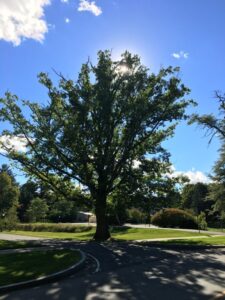
Honey locust (Gleditsia triacanthos). DBH 30”. H 85’. A street tree in front of the Milne Library opposite Field Park. Also known as the thorny locust because of the sharp thorns that grow on the trunk and branches, to deter browsers. Creamy white flowers. Drops 6-8” long red-brown seed pods in the fall.
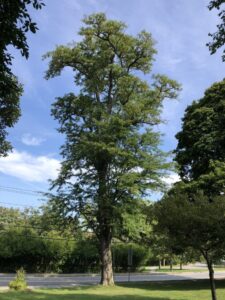
Turn back toward South St.
Dawn redwood (Metasequoia glyptostroboides). DBH 18”. H 48’. In front yard of CDE on Main St., opposite Field Park. A species of redwood, native to China. Fast-growing. Deciduous. Planted here in 1995, in recognition of the international students at CDE.
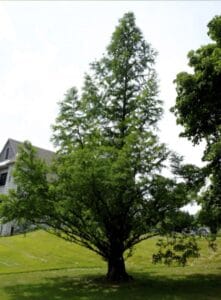
Bitternut hickory (Carya cordiformis). DBH 26”. H 106’. Sometimes called swamp hickory. On South St. between the CDE dorm and Garfield House. Related to the pecan, but its nuts are not edible.
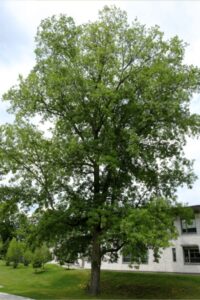
Black locust (Robinia pseudoacacia). DBH 32”. H 138’. This example, in front of Garfield House on South St., is the tallest tree on this tree walk. Needs a lot of sunlight. Leaves come out late in the spring. Creamy white fragrant flowers in early June. Look across South St. for another American elm.
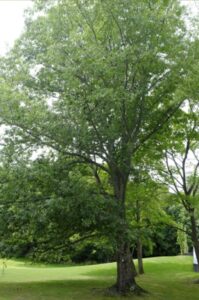
The tree walk turns left at the driveway to Agard House. Users may wish to walk further on South St. to the Clark Art Institute, where they can see fine examples of sugar maples and red oaks. To continue with the tour, follow the driveway around Agard House and continue past Thompson Health Center to Hoxsey St.
Atlantic white cedar (Chamaecyparis thyoides). DBH 29”. H 46’. At the front door of Pond House on the SE corner of Hoxsey St. and Walden St. Evergreen, native to Atlantic coast of the U.S. No branches on the lower part of the tree.
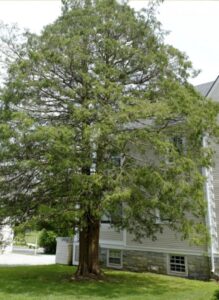
Silver maple (Acer saccharinum). DBH 61”. H 115’. In front of the next house on Walden St. Common throughout eastern North America. One of the tallest maple street trees in town. Growing here in the open, it is notably stout. See also #7.

This guide is also available to download as a tri-fold, printable brochure.

